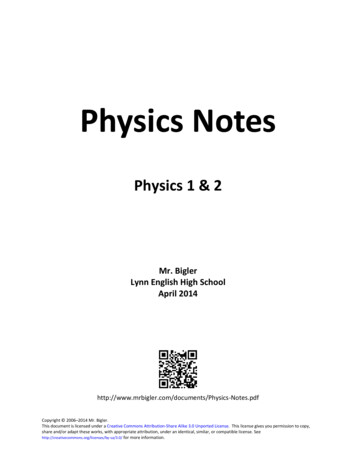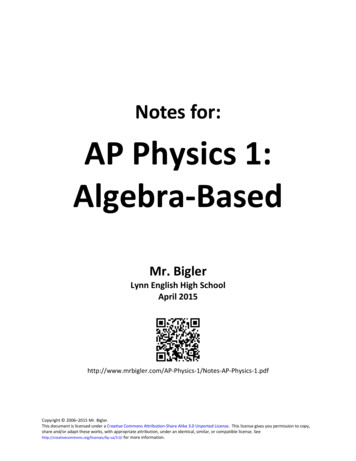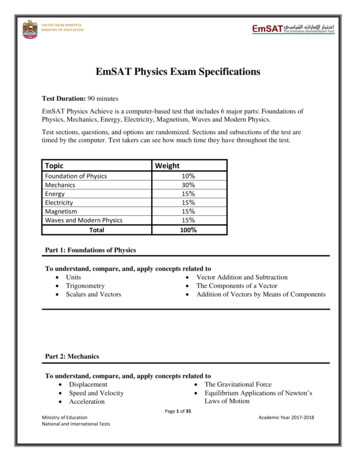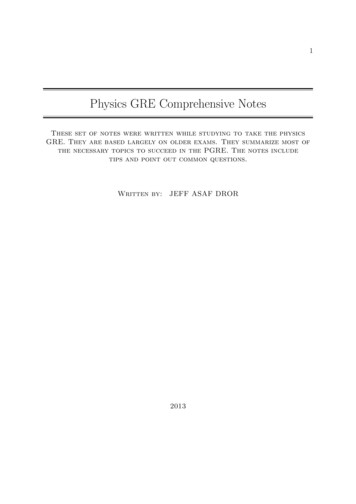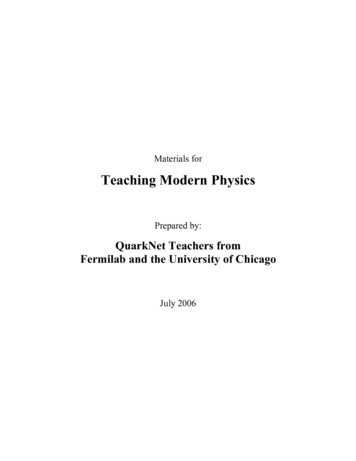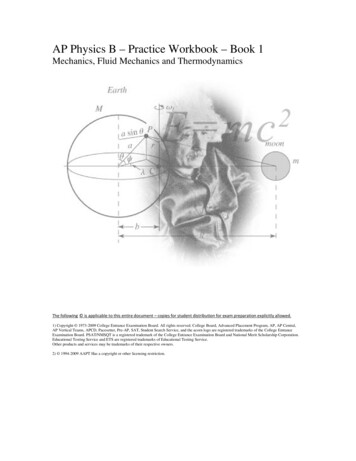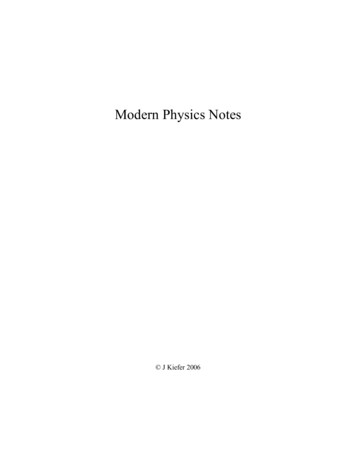
Transcription
Modern Physics Notes J Kiefer 2006
Table of ContentsTABLE OF CONTENTS. 1I.RELATIVITY . 2A.Frames of Reference. 2B.Special Relativity . 5C.Consequences of the Principle of Special Relativity . 8D.Energy and Momentum . 14E.A Hint of General Relativity. 19II.QUANTUM THEORY . 21A.Black Body Radiation. 21B.Photons . 27C.Matter Waves. 30D.Atoms. 37III.QUANTUM MECHANICS & ATOMIC STRUCTURE (ABBREVIATED) . 45A.Schrödinger Wave Equation—One Dimensional . 45B.One-Dimensional Potentials. 47D.The Hydrogen Atom. 52E.Multi-electron Atoms . 591
I.RelativityA.Frames of ReferencePhysical systems are always observed from some point of view. That is, the displacement,velocity, and acceleration of a particle are measured relative to some selected origin andcoordinate axes. If a different origin and/or set of axes is used, then different numerical values are obtained for r , v , and a , even though the physical event is the same. An event is a physicalphenomenon which occurs at a specified point in space and time.1.Inertial Frames of Referencea.DefinitionAn inertial frame is one in which Newton’s “Laws” of Motion are valid. Moreover, any framemoving with constant velocity with respect to an inertial frame is also an inertial frame of reference. While r and v would have different numerical values as measured in the two frames, F ma in both frames.b.Newtonian relativityQuote: The Laws of Mechanics are the same in all inertial reference frames. What does “thesame” mean? It means that the equations and formulae have identical forms, while the numericalvalues of the variables may differ between two inertial frames.c.Fundamental frameIt follows that there is no preferred frame of reference—none is more fundamental than another.2.Transformations Between Inertial Framesa.Two inertial framesConsider two reference frames—one attached to a cart which rolls along the ground. Observerson the ground and on the cart observe the motion of an object of mass m. The S’-frame is moving with velocity v relative to the S-frame. As observed in the two frames:2
′ x ′In S’ we’d measure t’, x’, and u x . t ′In S we’d measure t, x, and u x x. tb.Galilean transformationImplicitly, we assume that t t ′ . Also, we assume that the origins coincide at t 0. Thenx x ′ v x t ′y y ′ v y t ′z z ′ v z t ′ t t ′The corresponding velocity transformations aredx dx ′′ux vx u x vxdtdtdy dy ′′uy vy uy vydtdtdz dz ′′uz vz u z vzdtdtFor accelerationdu′ dvax x ax xdtdtdu ydvyay a y′ dtdtdu′ dvaz z az zdtdt′′Note that for two inertial frames, the a x a x , a y a y , and a z a z ′ .3
ExampleS-frame////du dp , if m is constant.F ma mdtdtS’-frame/////// dp ′//du // / / du dv , where p ′ mu ′ . But u ′ u v , so F ′ m F ′ ma ′ m F . That is,dtdt dt dt / /a a ′ , as they must for 2 inertial reference frames.Notice the technique. Write the 2nd “Law” in the S’-frame, then transform the position andvelocity vectors to the S-frame.4
B.Special Relativity1.Michelson-Morleya.Wave speedsMidway through the 19th century, it was established that light is an electromagnetic (E-M) wave.Maxwell showed that these waves propagate through the vacuum with a speed c 3 x10 8 m/sec.Now, wave motion was well understood, so it was expected that light waves would behaveexactly as sound waves do. Particularly the measured wave speed was expected to depend on theframe of reference. In the S-frame, the speed of sound is u ; in the S’-frame the speed is u ′ . The source and the/ / /medium are at rest in the S-frame. We find (measure) that u u ′ v , in conformity withNewtonian or Galilean relativity. We may identify a “preferred” reference frame, the frame inwhich the medium is at rest.b.Michelson-MorleyThroughout the latter portion of the 19th century, experiments were performed to identify thatpreferred reference frame for light waves. The questions were, what is the medium in whichlight waves travel and in what reference frame is that medium at rest? That hypothetical mediumwas given the name luminiferous ether (æther). As a medium for wave propagation, the ethermust be very stiff, yet offer no apparent resistance to motion of material objects through it.The classic experiment to detect the etheris the Michelson-Morley experiment. Ituses interference to show a phase shiftbetween light waves propagating thesame distance but in different directions.The whole apparatus (and the Earth) ispresumed to be traveling through the ether with velocity, v . A light beamfrom the source is split into two beamswhich reflect from the mirrors and arerecombined at the beam splitter—forming an interference pattern which isprojected on the screen. Take a look at5
the two light rays as observed in the ether rest frame.The sideward ray:The time required for the light ray to travelfrom the splitter to the mirror is obtainedfrom v2 (ct ) (vt ) t 1 2 c c 222 12.Now c v, so use the binomial theorem to simplify(1 x) n 1 v2 .t 1 c 2 c 2 n(n 1) 2x 1 nx 2!The total time to return to the splitter is twice this: t1 2t 2 1 v 2 1 .c 2 c 2 For the forward light ray, the elapsed time from splitter to mirror to splitter ist2 2 v 2 2 v 2 1 2 1 2 .c v c v c c c c The two light rays recombine at the beam splitter with a phase difference [let τ λ.]:c2 1 v 2 c v 2 t c (t 2 t1 ) .τλc 2 c2 λ λ c2 t 0 , the two light rays are out of phase even though they have traveled the sameτdistance. By measuring t one could evaluate v .Since However, no such phase difference was/is observed! So, there is no ether, no v with respect tosuch an ether. This null result is obtained no matter which way the apparatus is turned. Theconclusion must be that either the “Laws” of electromagnetism do not obey a Newtonianrelativity principle or that there is no universal, preferred, rest frame for the propagation of lightwaves.c.Expedients to explain the null resultlength contraction—movement through the ether causes the lengths of objects to be shortened inthe direction of motion.ether-drag theory—ether is dragged along with the Earth, so that near the Earth’s surface theether is at rest relative to the Earth.6
Ultimately, the expedients were rejected as being too ad hoc; it’s simpler to say there is no ether.This still implies that the “Laws” of electromagnetism behave differently under a transformationfrom one reference frame to another than do the “Laws” of mechanics.2.Postulates of Special Relativitya.Principle of Special RelativityIt doesn’t seem sensible that one “part” of Physics should be different from another “part” ofPhysics. Let’s assume that they are not different, and work out the consequences. This is whatEinstein did. He postulated that ‘All the “Laws” of Physics are the same in all inertial referenceframes.’b.Second PostulateThe second postulate follows from the first. ‘The speed of light in a vacuum is (measured to be)the same in all inertial reference frames.’When the speed of light is measured in the two reference frames, it is found that c c ′ v ,rather c c ′ . Evidently, the Galilean Transformation is not correct, or anyway not exact. In anycase, we assume the postulates are true, and work out the consequences.7
C.Consequences of the Principle of Special Relativity1.Time Dilationa.EventsAn event may be regarded as a single observation made at a specific location and time. Onemight say that an event is a point in space-time (x,y,z,t). Two events may be separated byintervals in either space or in time or in both.b.Time intervalsConsider a kind of clock:We observe two events: i) the emission of a flash at O’ and ii) thereception of the flash at O’. In this case, x ′ y ′ z ′ 0 . The2d ′time interval between the two events is t ′ .cNow let’s view the same two events from the point of view ofanother frame, S. As shown below, the S’-frame is moving to theright with speed v relative to the S-frame. In the S-frame, x 0 .2dThe elapsed time is t , where d 2 d ′ 2 2 . Substitute forcd , d ′ , and in terms of t , t ′ , c, and v.c 2 t 2 c 2 t ′ 2 v 2 t 2 444 c2 Solve for t t ′ 22 c v 12 t ′v21 2c.example (prob. 1-11 in the text)The lifetime of a pion in its own rest frame is t ′ 2.6 x10 8 sec. Consider a pion moving withspeed v 0.95c in a lab—what will be measured as its lifetime in the lab?8
t t ′ 2.6 x10 8 sec 2.6 x10 8 sec 8.33x10 8 sec .0.3121 0.95 2v2c2The lifetime of a fast-moving particle is measured by noting how far it travels before decaying.In this example v t 0.95c 8.33x10 8 sec 23.7 m. In practice, we measure and compute t .1 c.Proper timeThe proper time is the time interval measured by an observer for whom the two events occur atthe same place, so that x ′ y ′ z ′ 0 .2.Length Contractiona.“Contraction”Consider an object, such as a meter stick, of length L in itsown rest frame, S.A second frame, S’, moves to the rightwith a speed v relative to S.We observe two events:i) the point A passes the left end ofthe stickii) the point A passes the right endofthe stick.As measured in the S’ frame, L ′ v t ′and x ′ 0 .9
In the S frame, x L and t t ′. Therefore, L ′ v t 1 v2v2 L 1 2 .c2cv21 2cAn observer in the S’ frame observes the stick to be shorter (contracted) than does the observerin the S frame. Notice particularly that the stick is at rest in the S frame.The contraction takes place in the direction of the relative motion. Lengths perpendicular to vare not affected. So for instance in the situation discussed above the width and thickness of themeter stick are still measured the same in both reference frames.b.Proper lengthThe proper length of an object is that length measured in the rest frame of the object.3.Simultaneitya.Space-timeEach event has associated with it four numbers: x, y, z coordinates and a “value of time” whichwe read off a clock located at that spatial location. There is no central universal clock, ratherthere is a clock at every point in space.b.SynchronizationWe would like all clocks in a reference frame to display exactly the same readingsimultaneously, but can this be arranged? Only by the exchange of signals, which is another wayof saying only in terms of intervals. However, as we have seen, intervals are not the same forobservers in different inertial reference frames. Therefore, the concept of two events beingsimultaneous has no absolute meaning.c.Non-simultaneityTwo events viewed as simultaneous in one frame will not be seen as occurring simultaneously inanother frame.example: a train moving with constant velocity on a straight, smooth track. One observer rideson the train, the other observer stands beside the track.Flashes of light are emitted at the points C1 and C2 when the origins (O & O’) of the two framescoincide. To the trackside observer at O, the flashes are simultaneous. To the observer on thetrain, however, the flash emitted at C’2 is received before the flash emitted at C’1. Yet bothobservers measure the same speed of light, c.10
4.Lorentz TransformationNow we wish to derive the transformation equations for the displacement and velocity of anobject—the relativistic version of the Galilean transformation equations. In what follows, we’ll1.be setting γ v21 2ca.Two framesConsider two inertial reference frames, S & S’ and assume that O O’ at t’ 0.What is the x-distance from O to the point P, as measured in the S’ frame? In effect, then, we’llhave t t and t ′ t ′ . ′ x ′ vt ′xIn the S frame, x , so ′ also. Set ‘em equal.γx x ′ vt ′γx γ ( x ′ vt ′)x′On the other hand, as measured in the S frame, x vt . Set them equal.γx′γ ( x ′ vt ′) vt γSolve for t.x′vt γ ( x ′ vt ′) γv t γ t ′ 2 x′ c b.Transformation equationsWe have, then, for relative motion along the x-axis:v x γ ( x ′ vt ′) ; y y ′ ; z z ′ ; t γ t ′ 2 x ′ c 11
Notes: i) the inverse transformation is obtained by replacing v with –v.ii) for v c, these reduce to the Galilean transformation.c.4-vectorsSuppose that when O O’, a flash of light is emitted from the origin O. In the S frame, thedistance the light wave front travels in time t is r 2 x 2 y 2 z 2 c 2 t 2 . Measured in the S’frame, it’s r ′ 2 x ′ 2 y ′ 2 z ′ 2 c 2 t ′ 2 . Subtract the second expression from the first andcollect the S frame on one side of the equal sign, the S’ frame on the other side.r 2 r ′ 2 c 2t 2 c 2t ′2r 2 c 2t 2 r ′ 2 c 2t ′2There is this quantity, a generalized displacement (call it s) which is the same in the two inertialreference frames.s 2 s′2We see that the quantity (ict) “acts like” a component of displacement along a fourth axis. Theinterval between any two events in space-time is s 2 x 2 y 2 z 2 c 2 t 2 . The intervalis invariant under the Lorentz Transformation. That is, as measured in any two inertial frames, s 2 s′2 . This is an extension of the invariance of lengths under a rotation of the coordinateaxes.d.Transformation of velocitiesSince displacements and time intervals are transformed, obviously relative velocities won’t addsimply, either.In the S’ frame an object moves with constant velocity along the x axis; u ′x dx ′. Transform todt ′dx vu vγ (dx vdt )and similarly for the y and zthe S frame; u ′x dt xv 1 v dx 1 v uγ dt 2 dx xc 2 dtc2c components. While dy & dz are not contracted, dt is still dilated.example:u A 0.5c and u B 0.8c , both as measured in the S frame. The S’ frame rides along with spaceship B. Therefore, v u B .12
uA v 0.5c ( 0.8c) c 0.8cv21 2 uA1 2 0.5cccBe careful with the directions of the velocities.u ′A Note that when u c and v c , thenvu 0 and u ′ u v . On the other hand, if u c ,c2 v c 1 c vc c.then u ′ cvv1 21 cc13
D.Energy and MomentumWe require that all the “Laws” of Physics be the same in all inertial reference frames. Werequire further that when v c, we recover the familiar Newtonian forms of the “Laws.” Thislatter requirement is called a Correspondence Principle. What are those “Laws”?1.Conservation of MomentumWe define a relativistic momentum so that the two conditions above are satisfied. p γmuThis m is the rest mass—the mass measured by an observer at rest with respect to the object.This quantity should be the same in all inertial reference frames. With this definition, pinitial p final in all inertial reference frames.2.Relativistic Energya.Work-energy theorem (one dimensional)The work done by a force on an object changes its kinetic energy, thusx2 K W12 Fdx .x1x2dp dt dx K x1t2 K dp dxdtdt dtt1 K udpIntegrate by parts.u2u2 pdu K up u 1 K upRecall that udu u2muu2u1 u2u1m 2 u1duu21 2cdu 2.2 K upLook up the formu1 dxa bxin a math tables book.14du 21 u2c2
uu K up u212 u2 2 1 2 m c 1 2 2 c u1u 2 mu 2u2 2 K mc 1 2 2c u 1 2 uc1u 2 222 2 mu mc mu mc K 2uu2 1 21 2 ucc 1Now, if we started from rest, then u1 0 and u2 u and K mc 21 2uc2 mc 2 . Therefore, wedefine the relativistic kinetic energy to beK mc 22 mc 2 .uc2The quantity mc2 is called the rest energy, because it’s independent of u. The total relativisticenergy is E K mc2 V, where V is the potential energy, if any. If V 0, thenE K mc 2 γmc 2 .1 b.Energy-momentum relationTake a look at the quantity (V 0) 2 2m cm c u22 42 42 m u m c cE m c u2u2u2 1 21 21 2ccc 22 42 2E m c c p2 42 2 2E 2 c 2 p 2 m2c 4For photons, m 0 and E pc.15 .
c.Units of mass-energyIt is convenient to express energy in units of electron-volts (eV). An electron-volt is the energygained by an electron upon being accelerated through a one Volt potential difference. Thus 1 eV 1.60x10-19Joules. The rest energy of an electron is()2mc 2 9.11x10 31 kg 3 x10 8 m / sec 8.20 x10 14 J 0.511x10 6 eV 0.511MeV .Often, mass is expressed in terms of MeV/c2 so that the electron mass is 0.511MeV/c2.Sometimes, the c2 is dropped, but it’s understood to still be there. Similarly, momentum isexpressed in terms of MeV/c, since pc units of MeV.3.Relativistic Mechanicsa.ForceWe want the “Laws” of Mechanics to be invariant under the Lorentz Transformation. Also, wewant to recover the classical result when u c. So, we define the relativistic force componentmu xdp.to be Fx x , where p x dtu21 2cLet’s say the motion and force are entirely along the x-direction. dumd 1 d mu F mu2 2 dt2 dt dt uu 1 u 1 1 c2c 2 c 2 F m1 u2c22du 1 u mu 1 2 dt 2 c 32 2u du 2 c dt 1 3 du u 2 2 u 2 u 2 2 1 F m 2 1 2 dt c 2 c c Solve for the acceleration. 1F m u2 1 2c 32du F u 2 1 dt m c 2 16dudt32
du 0 , no matter how large the applied force. At the otherdtdu F .extreme, when u c,dt mThe result is, that as u c ,b.Collisions—conservation of momentumConsider the collision of two billiard balls. They have equal masses, m. Let’s say that one ballis initially at rest while the second ball has momentum po and energy Eo before the collision.After the collision, both balls have the same energy, E, and mass, m. It’s an elastic collision.Momentum and energy are conserved.In the x direction, po 2 p cosθ . Substitute for po and p using E2 p2c2 m2c4.12E o2 m 2 c 4 E 2 m 2 c 4 cosθccConservation of energy allows us to eliminate E, since it was given that E o mc 2 2 E . Keepin mind that Eo is the relativistic total energy of the second ball, while mc2 is the rest energy ofthe first (target) ball. At the same time, we solve for cosθ , the cosine of the scattering angle.cosθ Eo2 m 2 c 4(Eo mc 2)2 4m 2 c 4cosθ (E mc )(E mc )(E 3mc )(E mc )ooEo mc 2Eo 3mc 2In the classical limit, Eo mc 2 and therefore2mc 21cos θ θ 45 o . But, as Eo 224mc2mc , cosθ 1 θ 0 o !c.Decay of a high-energy particleAn unidentified high-energy particle is observed todecay into two pions ( π mesons), as shown.1722oo22
Knowing the momenta and masses of the decay products, we determine the mass of the incidentparticle, hoping to identify it.MeVMeV, p 2 323, m1c 2 m2 c 2 mc 2 139.6Mev .p1 910ccThe energy and momenta are conserved. The total energy isE o E1 E 2 p12 c 2 m 2 c 4 p 22 c 2 m 2 c 4E o 921MeV 352MeV 1273MeVThe quickest way to obtain the magnitude of the incident momentum is to use the law of cosines:p o2 c 2 p12 c 2 p 22 c 2 2 p1 p 2 c 2 cos θ 1034229 MeV 2po c 1017 MeVNow that we have the total energy and the kinetic energy, the mass is obtained fromE o2 po2 c 2 mo2 c 4mo c 2 E o2 po2 c 2 765MeVEvidently, the incident particle was a ρ meson. What was its speed before it decayed? Well,the total energy is also Eo2 mo2c 4, so solve that for u.u21 2cmo2 c 4u 1 0.8cEo2d.Mass-energy equivalenceWhen we speak of the total energy being conserved that includes the total rest energy. Forinstance, consider the decay of a neutron that is initially at rest.n p e νThe neutron decays into a proton, an electron and an anti-neutrino. The three product particlesare observed to have total kinetic energy of K 0.781 MeV. The initial energy is just the restenergy of the neutron, Ei 939.57 MeV. The total final energy isE f m p c 2 me c 2 K 938.28MeV 0.511MeV 0.781MeV 939.57 MeVNotes: i) The rest energy of the anti-neutrino is too small to bother with.ii) Keep in mind the rounding of numbers and significant digits when substitutingnumerical values into the formulae.iii) Notice that mn m p me . A portion of the neutron’s rest energy has beenconverted into kinetic energy.18
E.A Hint of General Relativity1.EquivalenceIn Special Relativity it is asserted that all inertial reference frames are equivalent—the “laws” ofphysics are the same in all inertial reference frames. No experiment done in one frame candetect its uniform motion relative to another frame. Can the same be said for reference framesthat have a relative acceleration?a.ElevatorRecall the past discussion of a person standing in anelevator. If the elevator moves perfectly smoothly andthere are no floor indicator lights, then the person insidewill have no perception of the elevator’s motion, exceptfor feeling perhaps the elevator floor pressing upwardon his or her feet. [Keep in mind: the person gets noinformation from any source outside the reference frameof the elevator.] Contrast this situation with that ofanother person standing in a similar elevator, but thiselevator is simply resting level on the Earth’s surface.The person in this elevator also feels the floor pressingupward on his or her feet, also has no perception of theelevator’s motion. We, as omniscient externalobservers, know that this second elevator is resting on the surface of a planet, and that what theperson inside is experiencing is the gravitational force exerted by that planet. The point is thatthere is no experiment that either of the persons inside the elevators could perform that woulddistinguish between the two situations. Pendula would swing back and forth just the same;projectiles would follow the same kinds of arcs, etc.b.Light and gravityImagine ourselves as observers far from any source of gravitational force. Nearby, we observe a closed “elevator” which is accelerating, relative to us, at a constant rate, ao . A person standinginside the “elevator” sends a series of light pulsestoward one wall—he or she and we see the light pulsesdropping toward the floor as they approach the wall.The light follows a curved path inside the elevator.The Postulate of General Relativity asserts that the“laws” of physics have the same form for observers inany frame of reference, regardless of its accelerationrelative to another frame. We have seen that anaccelerated frame is equivalent to one in a gravitationalfield. It follows that the force of gravity must affect abeam of light just as it affects the motion of a massiveprojectile. Indeed, experiment has shown that it does.But, light has no mass.19
2.CurvatureClassically, we would say that a mass, such as a planet, exerts a gravitational force on anothermass, such as a moon or a person. However, a person in an “elevator” cannot determine whetherhis or her “elevator” is in the gravitational field of a planet or is being accelerated at a constantrate by, say rocket motors. If the “elevator” is in a gravitational field, we can nonethelessmathematically transform the “laws” of physics into versions of the same mathematical form thatdo not include gravity yet which make equally accurate predictions of the motions of particlesand of light beams.What Einstein did was to formulate such a version of the “laws” of motion. Objects and lightbeams move always in straight lines, but in a curved space-time. Empty space-time is flat, butthe presence of mass at any location curves space-time to a degree proportional to the amount ofmass that is present.Predictions of General Relativity:Precession of orbits—MercuryGravitational redshift—time runs slower in intense gravitational fieldGravitational lensing—light paths curvedGravitational waves—ripples in space time(?); slowing binary neutron stars20
II.Quantum TheoryA.Black Body Radiation1.Equilibrium Between Matter and Radiationa.Thermal equilibriumImagine a closed oven, maintained at a constant temperature, To. Inside, E-M waves bouncefrom wall to wall, being absorbed and re-emitted over and over. Ultimately, the radiation isrendered homogeneous, isotropic and unpolarized. A thermometer placed in the center of theoven will stabilize at a temperature T To . The radiation is said to be in thermal equilibriumwith the walls of the oven.b.EmissivityFrom thermodynamics (Kirchhoff) the power radiated by a body in thermal equilibrium withradiation is expressedEfJ ( f ,T ) ,Afwhere J is the power radiated per unit area per unit frequency, Ef is the emissivity or intensity perunit frequency of the radiation emitted by the body and , Af is the fractional absorption of thebody for radiation of frequency f. Notice that the substance of which the body is made is notimportant. For a black body, A f 1.0 for all f. The observed spectrum of radiation emitted by ablack body looks qualitatively like this:c.Model for a black bodyOne physical model for an ideal black body is a small opening in thewall of a heated cavity. Because the opening is small, a light rayentering through the opening is very unlikely to bounce back outagain. Conversely, any light ray that exits through the opening willhave reached equilibrium with the interior walls, having bounced offthe walls many times. The black body is not the oven as a whole,but the opening in the oven wall.21
2.Stefan-Boltzmann “Law”a.EmissivityThe total emissivity is obtained by integrating Efdf. E E f df0This quantity was found experimentally by J. Stefan to be proportional to T4.E σT 4Subsequently, Boltzmann derived this result from Maxwell’s equations. The proportionalityWconstant is called the Stefan-Boltzmann constant, σ 5.67 x10 8 2 4 or Wm-2K-4. For nonm K4black bodies, E aσT , where a 1.b.Wien’s displacement “law”Experimentally, λmax T 2.898 x10 3 m K , or3.Rayleigh-Jeans “Law”a.Wien’s exponential “law”cf max T 2.898 x10 3 m K .4J ( f ,T ) ,cwhere u is the energy per unit volume per unit frequency. As derived from thermodynamics andMaxwell’s equations,u( f , T ) β fTu ( f , T ) Af 3 ewhere A and β are constants. When tested by experiment, this expression fails at longwavelengths. But, Wien’s exponential “law” fits well near the peak, at f max .b.Rayleigh’s approachRayliegh proposed that the energy density be expressed as the product of the number of standingwave modes in the cavity and the average energy of each mode. Let N(f)df be the number ofmodes between f and f df.udf N ( f ) E df22
We need to obtain expressions for N(f) and for E . Picture standing waves in a cavity. In onedimension:We imagine the whole volume of the cavity occupied withstanding E-M waves, of many different frequencies. The radiationis in equilibrium with the walls of the cavity, at temperature T.Classically, the probability that there will be a mode of energy, E,in the cavity is given by the Boltzmann distribution. EP ( E ) e k BTThe average energy per mode is therefore E Ee0 e E Ek BTk BTdE(k B T )2 dEk BT k BT0As for N(f), the density of states, consider a cubical box of side L.Inside the box, the x-component of the E-field satisfies the wave equation 2 E x k 2 E x 0 . Ifwe assume that E x u ( x)v( y ) w( z ) , then we get three separated equations. The one for u(x) isd 2u k x2 u 0 ,2dxwhich has the solution u ( x) u o sin k x x . Similarly, v( y ) vo sin k y y and w( z ) wo sin k z z .The quantity k2 is like the square of a radius in k-space: k 2 k x2 k y2 k z2 . Since we must havestanding waves in the box, with the electric field vanishing at the walls, k x n yπn xπ, ky LLn zπ, where the nx, ny and nz are positive integers. In other words, only discrete pointsLin k-space designate the allowed energy modes in the cubical cavity. So, we count the number ofk-points lying in a spherical shell of radius k and thickness dk.and k z 23
3 π We see that each point occupies a volume so the number of points in the shell is L 14πk 2 dkVk 2 dk ,N (k )dk 832π 2 π L 3where V L . Finally, there are two perpendicular polarizations for each mode, so the number ofmodes per unit volume (the density of states) isN (k )k 2 dkdk 2 .Vπ2N( f )8πf dfkc, since f .In terms of frequency,df 3V2πcAt last the energy density is8πf 2k B Tdf .c3Alter
Physics. Let’s assume that they are not different, and work out the consequences. This is what Einstein did. He postulated that ‘All the “Laws” of Physics are the same in all inertial reference frames.’ b. Second Postulate The second postulate follows from the f

